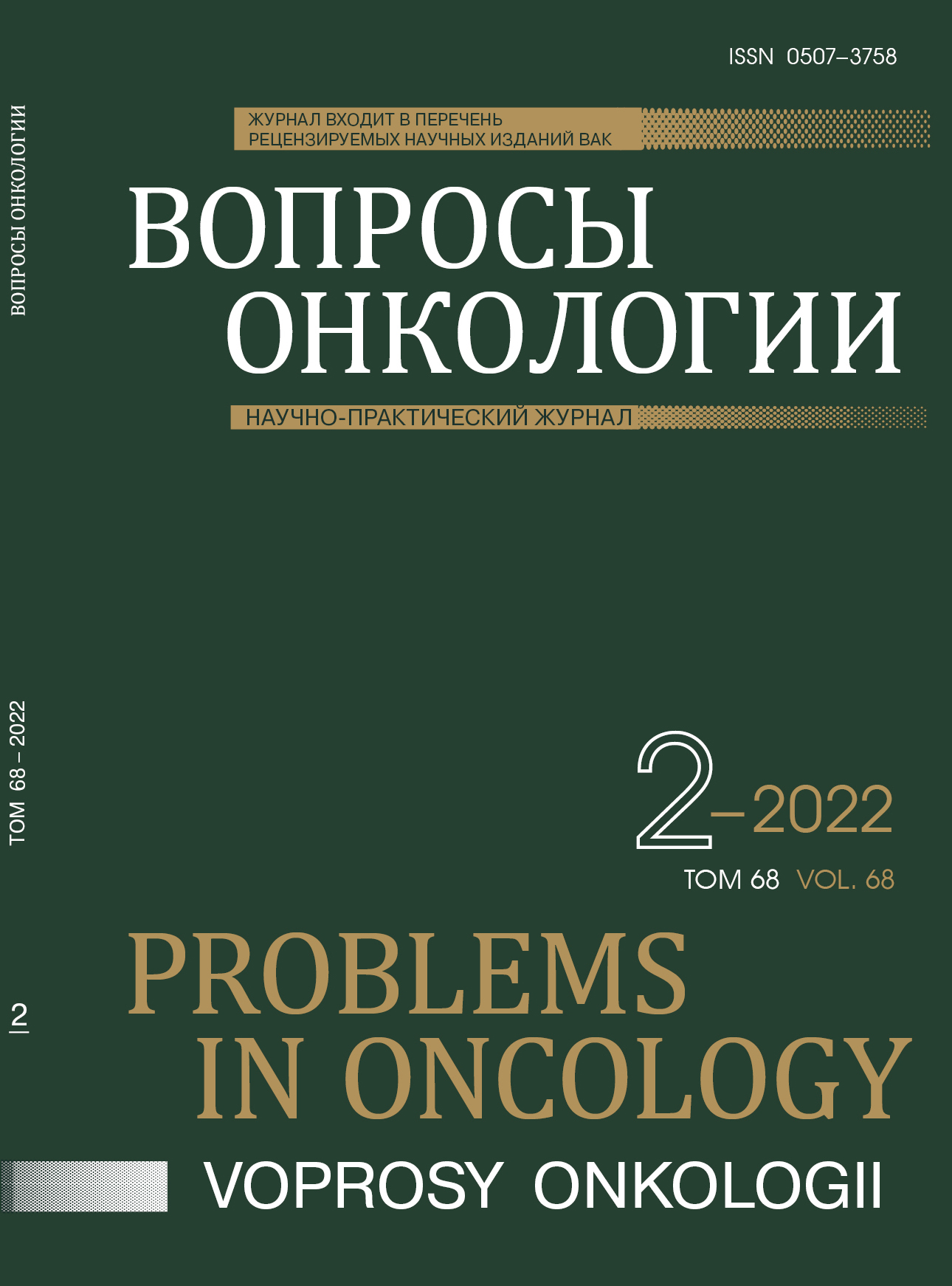Abstract
Background. The detection of translocations involving genes of the NTRK family in patients with non-small cell lung cancer (NSCLC) is a serious technical challenge. This is due to the presence of a large number of partner genes, breakpoints in them, and the presence of alternative splicing in the NTRK genes themselves.
The aim of this work was to develop an effective method for diagnosing NTRK translocations, as well as to analyze the frequency and spectrum of these rearrangements in NSCLC.
Materials and methods. We have developed a combined NTRK translocation search method based on a reverse transcription PCR reaction. The method consists of 2 stages: primary PCR with analysis of unbalanced expression of NTRK genes and a series of variant-specific PCRs to identify frequent variants of rearrangements.
Results. In a sample of 5102 patients with NSCLC, 9 cases of unbalanced expression of one of the NTRK genes were found. Using variant-specific PCR, the presence of rearrangements was confirmed in 2 of these 9 NSCLC. The rest of the samples demonstrating the phenomenon of unbalanced expression were analyzed by high-throughput next generation RNA sequencing (NGS), as a result of which 4 more NTRK translocations were found. Thus, a total of 6 rearrangements were identified with the participation of genes of the NTRK family (6/5102, 0.12%): SQSTM1ex5/NTRK1ex9, TPM3ex8/NTRK1ex10, CD74ex6/NTRK1ex10, FAM118Bex8/NTRK1ex9, SQSTM1ex4/NTRK2ex14, ETV6ex5/NTRK3ex15. The FAM118B/NTRK1 translocation has not been previously described in the literature.
Conclusion. The combination of 2 different PCR tests seems to be an adequate approach for diagnosing rearrangements involving the NTRK1, NTRK2, NTRK3 genes. Systematic screening for unbalanced expression of NTRK genes makes it possible to identify new variants of clinically significant translocations in NSCLC.
References
van der Geer P, Hunter T, Lindberg RA. Receptor protein-tyrosine kinases and their signal transduction pathways // Annu Rev Cell Biol. 1994;10:251–337.
Huang EJ, Reichardt LF. Trk Receptors: Roles in Neuronal Signal Transduction // Annu Rev Biochem. 2003;72:609–642. doi:10.1146/annurev.biochem.72.121801.161629
Deinhardt K, Chao MV. Trk Receptors. In: Lewin GR, Carter BD, editors. Neurotrophic Factors [Internet]. Berlin, Heidelberg: Springer. 2014:103–119. doi:org/10.1007/978-3-642-45106-5_5
Doebele RC, Davis LE, Vaishnavi A et al. An oncogenic NTRK fusion in a patient with soft-tissue sarcoma with response to the tropomyosin-related kinase inhibitor LOXO-101 // Cancer Discov. 2015;5:1049–1057.
Scott LJ. Larotrectinib: First Global Approval // Drugs. 2019;79:201–206. doi:10.1007/s40265-018-1044-x
Doebele RC, Drilon A, Paz-Ares L et al. Entrectinib in patients with advanced or metastatic NTRK fusion-positive solid tumours: integrated analysis of three phase 1–2 trials // Lancet Oncol. 2020;21:271–282. doi:10.1016/S1470-2045(19)30691-6
Solomon JP, Linkov I, Rosado A et al. NTRK fusion detection across multiple assays and 33,997 cases: diagnostic implications and pitfalls // Mod Pathol. 2020;33:38–46. doi:10.1038/s41379-019-0324-7
Amatu A, Sartore-Bianchi A, Siena S. NTRK gene fusions as novel targets of cancer therapy across multiple tumour types // ESMO Open. 2016;1:e000023.
Gatalica Z, Xiu J, Swensen J, Vranic S. Molecular characterization of cancers with NTRK gene fusions // Mod Pathol. 2019;32:147–153. doi:10.1038/s41379-018-0118-3
Solomon JP, Hechtman JF. Detection of NTRK Fusions: Merits and Limitations of Current Diagnostic Platforms // Cancer Res. 2019;79:3163–3168. doi:10.1158/0008-5472.CAN-19-0372
Iyevleva AG, Raskin GA, Tiurin VI et al. Novel ALK fusion partners in lung cancer // Cancer Lett. 2015;362:116–121. doi:10.1016/j.canlet.2015.03.028
Preobrazhenskaya EV, Iyevleva AG, Suleymanova AM et al. Gene rearrangements in consecutive series of pediatric inflammatory myofibroblastic tumors // Pediatr Blood Cancer [Internet]. 2020 [cited 2020 Jun 22];67. doi:10.1002/pbc.28220
Brzeziańska E, Karbownik M, Migdalska-Sęk M et al. Molecular analysis of the RET and NTRK1 gene rearrangements in papillary thyroid carcinoma in the Polish population // Mutat Res Mol Mech Mutagen. 2006;599:26–35. doi:10.1016/j.mrfmmm.2005.12.013
Chomczynski P, Sacchi N. Single-step method of RNA isolation by acid guanidinium thiocyanate-phenol-chloroform extraction // Anal Biochem. 1987;162:156–159. doi:10.1006/abio.1987.9999
Wang R, Pan Y, Li C et al. The Use of Quantitative Real-Time Reverse Transcriptase PCR for 5′ and 3′ Portions of ALK Transcripts to Detect ALK Rearrangements in Lung Cancers // Clin Cancer Res. 2012;18:4725–4732. doi:10.1158/1078-0432.CCR-12-0677
Zito Marino F, Pagliuca F, Ronchi A et al. NTRK Fusions, from the Diagnostic Algorithm to Innovative Treatment in the Era of Precision Medicine // Int J Mol Sci. 2020;21:E3718. doi:10.3390/ijms21103718

This work is licensed under a Creative Commons Attribution-NonCommercial-NoDerivatives 4.0 International License.
© АННМО «Вопросы онкологии», Copyright (c) 2022
